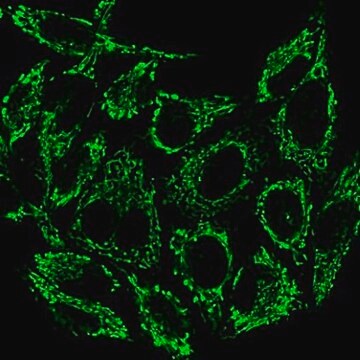235400
Caspase-3 Substrate I, Colorimetric
Colorimetric substrate for caspase-3 (Km = 9.7 µM) and related cysteine proteases.
Sinónimos:
Caspase-3 Substrate I, Colorimetric, Ac-DEVD- pNA, Ac-DEVD-pNA
Iniciar sesiónpara Ver la Fijación de precios por contrato y de la organización
About This Item
Fórmula empírica (notación de Hill):
C26H34N6O13
Número de CAS:
Peso molecular:
638.58
Código UNSPSC:
12352200
Productos recomendados
Análisis
≥95% (HPLC)
formulario
lyophilized
fabricante / nombre comercial
Calbiochem®
condiciones de almacenamiento
OK to freeze
desiccated
protect from light
solubilidad
DMSO: 60 mg/mL
Condiciones de envío
ambient
temp. de almacenamiento
−20°C
Descripción general
Colorimetric substrate for CPP32/Apopain/Yama (Km = 9.7 µM) and related cysteine proteases. Sequence is based on the P1-P4 tetrapeptide cleavage site of poly (ADP-ribose) polymerase (PARP) and includes Asp216. CPP32 is the protease responsible for the cleavage of PARP. Can be used with Pro-caspase-3 in in vitro assays to measure caspase-9 activity, since caspase-9 activates pro-caspase-3. Cleavage of the substrate can be monitored at 405 nm (ε = 9160 cm-1M-1).
Colorimetric substrate for caspase-3 (Km = 9.7 µM) and related cysteine proteases. Sequence is based on the P1-P4 tetrapeptide cleavage site of poly(ADP-ribose) polymerase (PARP) and includes Asp216. Caspase-3 is the protease responsible for the cleavage of PARP. Also a substrate for caspase-6, caspase-7, caspase-8, and caspase-10. Cleavage of pNA is monitored colorimetrically at ~405 nm.
Acciones bioquímicas o fisiológicas
Cell permeable: no
Km = 9.7 µM as colorimetric substrate for caspase-3
Primary Target
Caspas-3
Caspas-3
Product does not compete with ATP.
Reversible: no
Advertencia
Toxicity: Standard Handling (A)
Secuencia
Ac-Asp-Glu-Val-Asp-pNA
Reconstitución
Following reconstitution, aliquot and freeze (-20°C). Stock solutions are stable for up to 6 months at -20°C.
Otras notas
Cardone, M.H., et al. 1998. Science 282, 1318.
Thornberry, N.A., and Lazebnik, Y. 1998. Science 281, 1312.
Nicholson, D.W., et al. 1995. Nature376, 37.
Lazebnik, Y.A., et al. 1994. Nature371, 346.
Thornberry, N.A., and Lazebnik, Y. 1998. Science 281, 1312.
Nicholson, D.W., et al. 1995. Nature376, 37.
Lazebnik, Y.A., et al. 1994. Nature371, 346.
Información legal
CALBIOCHEM is a registered trademark of Merck KGaA, Darmstadt, Germany
Código de clase de almacenamiento
11 - Combustible Solids
Clase de riesgo para el agua (WGK)
WGK 1
Punto de inflamabilidad (°F)
Not applicable
Punto de inflamabilidad (°C)
Not applicable
Certificados de análisis (COA)
Busque Certificados de análisis (COA) introduciendo el número de lote del producto. Los números de lote se encuentran en la etiqueta del producto después de las palabras «Lot» o «Batch»
¿Ya tiene este producto?
Encuentre la documentación para los productos que ha comprado recientemente en la Biblioteca de documentos.
Konrad A Szychowski et al.
Pesticide biochemistry and physiology, 168, 104638-104638 (2020-07-28)
Triclosan (TCS) is commonly used worldwide in a range of personal care and sanitizing products. A number of studies have revealed the presence of TCS in human tissues. It has recently been shown that TCS can interact with AhR in
Nuestro equipo de científicos tiene experiencia en todas las áreas de investigación: Ciencias de la vida, Ciencia de los materiales, Síntesis química, Cromatografía, Analítica y muchas otras.
Póngase en contacto con el Servicio técnico